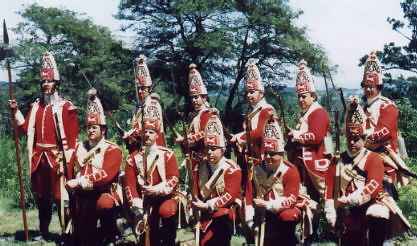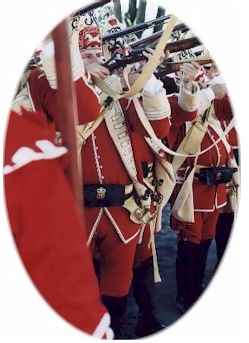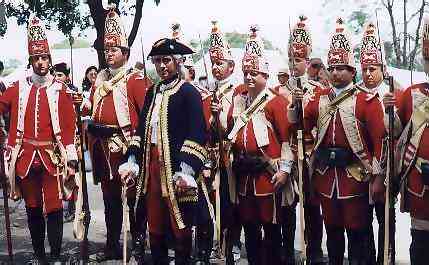
 |
|
| |
Visit the Seven Year War Website
His
Majesty's 40th Regiment of Foot
Hopson's Grenadiers
1755-1763

The 40th Grenadiers at Ticonderoga, 1998
(all photos by Ron Ridley)
Welcome to the homepage of the re-created Grenadier Company of His Britannic Majesty’s 40th (Hopson’s) Regiment of Foot (circa 1759). Formed in 1994 by museum professionals, heritage artisans and history enthusiasts, the group is dedicated to commemorating the history of the Seven Years’ War (sometimes referred to as the French and Indian War) in North America.
A Brief History
The Seven Years’ War
The Seven Years’ War (1754-1763) was a decisive chapter in the history of both Canada and the United States. The conflict, which had raged on battlefields in both Europe and North America, formally came to an end with the signing of the Treaty of Paris in 1763. Under the terms of the treaty, New France was ceded and Great Britain established its supremacy over much of North America. For Canada, it marked the beginning of political, legal and military traditions which endure to this day, while for the United States, the fall of New France and a nascent sense of colonial grievance laid the foundation for the outbreak of the American Revolution a scant twelve years later.
The period was marked by significant events and personalities. An ambitious young British officer named James Wolfe achieved fame at the Siege of Louisbourg in 1758 and died victorious in the Battle of the Plains of Abraham at Quebec the following year. Guy Carleton (later Lord Dorchester), wounded on the Plains, later became Governor General of Canada and was responsible for the passage of the Quebec Act. The French, under the skilled leadership of officers such as Montcalm, de LÚvis and Bourlamaque valiantly defended New France and won significant victories at Carillon (Ticonderoga) and Ste-Foy, while in campaigns against the French in the wilds of the Ohio valley, an obscure Virginia militia officer named George Washington first gained prominence.
The 40th Regiment
Raised in Nova Scotia and Newfoundland in 1717, the 40th Regiment saw extensive service during the Seven Years War. At this time the regiment was often referred to by its colonel's name, Major General Peregrine Hopson. In 1755, prior to the official declaration of war in Europe, British forces with part of Hopson's Regiment took the initiative and attacked Fort Beausejour on Chignecto isthmus of Nova Scotia. After a short siege the fort fell to British arms.
The next action the regiment would see was in the capture of the fortress of Louisbourg in 1758. The Grenadier Company was detached from the regiment and served with General James Wolfe in his daring landing in Garbarus Bay against an entrenched enemy. Only with the point of the bayonet were the Grenadiers able to dislodge the French and maintain their beach head. Hopson's Grenadiers continued under Wolfe and were employed in the construction and manning batteries on Lighthouse Point that inflicted extensive damage on Louisbourg's defenses. Other members of the 40th fought off sorties from the French. Finally after a two month siege, Louisbourg fell.
The following year in 1759, Wolfe returned to Louisbourg and formed a special corps called the Louisbourg Grenadiers which was made up of the Grenadiers of the 22nd, 40th and 45th Regiments. After personally training them in the "New Exercise", an improved musket drill, Wolfe set off for Quebec. During this campaign, the 40th Grenadiers served constantly skirmishing, fortifying, plundering, and fighting. They were front and centre at the failed attempt at Montmorency Falls, and on September 13th fought on the Plains of Abraham with Wolfe being mortally wounded leading them into the charge. Days later they received the honour of posting the first guards at the gates of Quebec. The following year the entire 40th Regiment (less one company in Newfoundland) returned to be a part of the surrender of Montreal and the fall of New France.
With the war still raging on in Europe, Britain turned its attention to France and Spain's holdings in the West Indies. The 40th was dispatched with a number of the regiments and captured Martinique, Grenada, St. Vincent, St. Lucia, and successfully laid siege to Havana, Cuba. Following the war in 1763, the regiment returned to Nova Scotia, but their stay was short and the following year the 40th Regiment left North America for the first time bound for Great Britain.
Other Articles of Interest:
His Majesty's 40th Regiment of Foot in North America, 1717-1764 This is a more detailed history of this famous Regiment.
A Soldier's Account of the Campaign on Quebec, 1759 This is an original account of the services of the Louisbourg Grenadiers by the Sergeant Major of the 40th Grenadiers.
An Historical Note on Grenadiers
In the eighteenth century, Grenadiers were the elite troops of the British army. The term "grenadier" is derived from the fact that these troops originally hurled iron or porcelain grenades into enemy positions, although by the mid-eighteenth century this practice had ceased.
Composed of the tallest and fittest men in a battalion of infantry, the grenadiers were normally assigned the most difficult and dangerous duties. The motto they proudly wore on their distinctive mitre caps NEC ASPERA TERRENT (Difficulties daunt us not) was a reflection of this as were the infantry hangers (swords) and brass matchcases which they wore. Their deeds have been immortalized in the song "British Grenadiers" which is played by military bands to this day.
The Reenactment Unit

The re-created Grenadier Company of the 40th Foot, portrays the unit as it would have appeared while on campaign in North America in 1759. Extensive archival and material culture research was carried out in Canada, the United States and Britain to ensure that the clothing and accoutrements worn by the group are as authentic as possible. To that end, no synthetic fabrics are used, wool is custom dyed to match original shades and all visible stitching is hand sewn, as is all of the leather work.
Where possible, period garments, accoutrements and construction techniques were examined in detail. However, no original period artefacts are used by the group.
The military drill which is employed is the "New Exercise", which was published in Dublin in 1758, and in which the Grenadiers of the 40th Regiment received instruction at Louisbourg under Wolfe’s watchful eye that same year.
The result is one of the most accurate impressions of British regular troops of this period.
With a number of talented museum professionals in the ranks who have taught National courses on black powder safety, have been or are in charge of national historic site, provincial and state black powder programmes, the 40th Grenadiers make safety a chief concern both on and off the field.
The members of the group are volunteers from a variety of professions who share a common interest in the history of the period. Events in which the Grenadiers of the 40th participate are held annually at a variety of historic sites in Canada and the United States.
Events
Since a number of our members are active as regimental commanders in other periods, and very involved in professional pursuits, the number of events attended each year is kept to two or three (one of them designated as the Major Event).

The 40th Regiment with the direct
descendant of Marquis de Montcalm
Special Thanks
Special thanks goes to Access Heritage Inc for their assistance in making our dress and accoutrements of museum Quality and for their hosting of our site on their Seven Years War Website.

Serjeant of the 40th Grenadiers